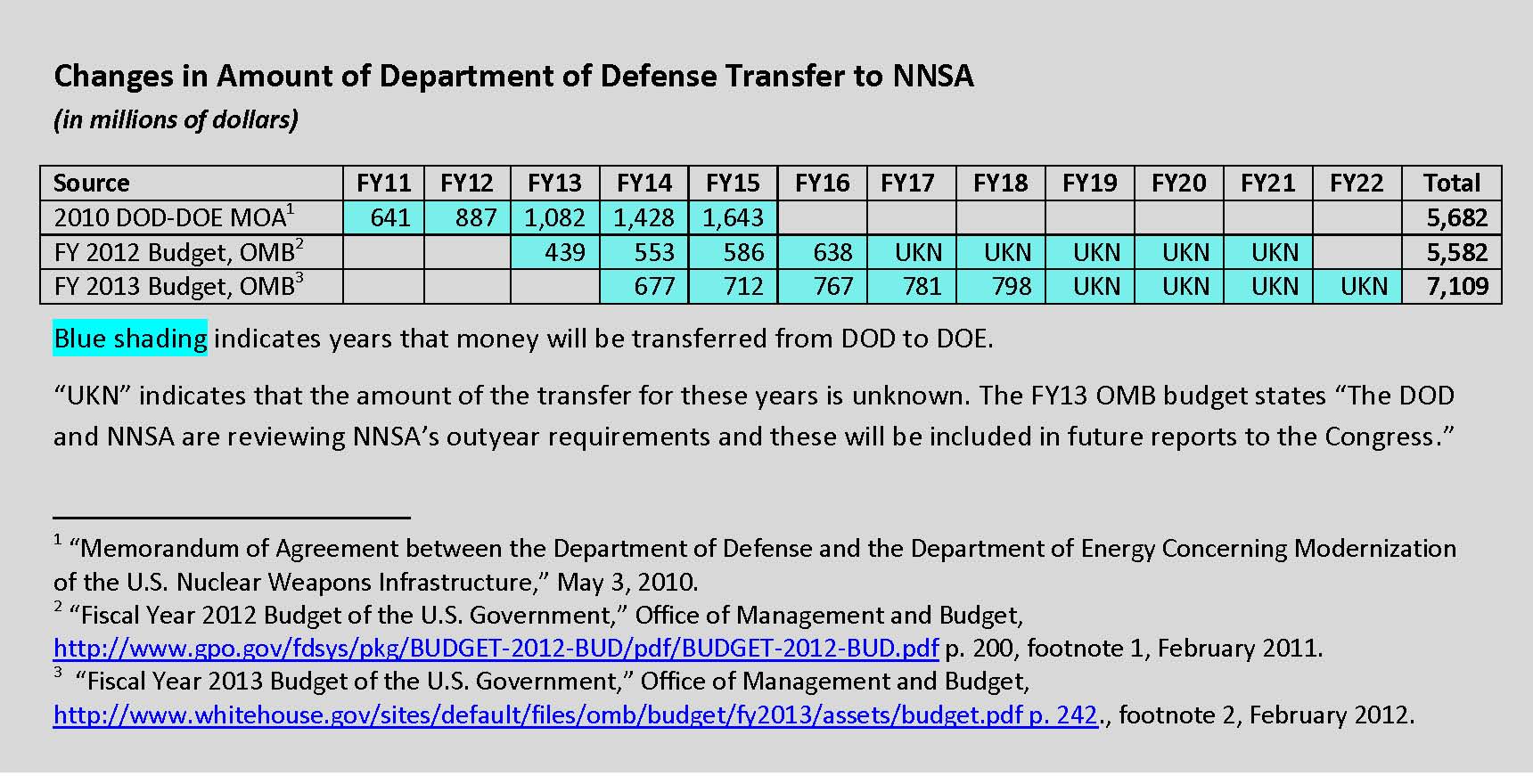In 2010, Secretary of Defense Robert Gates and Secretary of Energy Steven Chu signed an unprecedented agreement under which the DOD agreed to transfer large sums of money to DOE over the following five years to ensure the National Nuclear Security Administration (NNSA) could complete several major projects that the Pentagon supported, but that NNSA could not otherwise afford. The document has not been previously released.
The agreement has had the unintended consequence of highlighting NNSA’s troubled cost-estimating process. The agreement also muddles a long-standing divide between civilians and the military on nuclear weapons. In the early days, it was decided that civilians should control both the decision to use nuclear weapons and their production. The military built the delivery systems and handled implementation (that is, targeting and delivery). That division is reflected both in the Congressional appropriations process and in the government. The House and Senate Energy and Water Development appropriations committees make final decisions on funding for nuclear weapons development and production, the work done by the DOE/NNSA. Pentagon funding is handled separately in the Defense appropriations committees. This is partly related to the history of the Army Corps of Engineers, which ran the Manhattan Project. Because it does mostly civilian work on water projects, the Corps was and is funded by the Energy and Water appropriations bill.
Today, the Nuclear Weapons Council—a joint DOD-DOE decision-making body—makes the major choices about requirements for nuclear weapons and their maintenance, but the NNSA (and it predecessors) have relatively free rein in deciding how to meet those requirements.
The 2010 agreement is shifting that dynamic. Now, with the DOD providing money directly to NNSA, the Pentagon has become much more interested in how that money is being spent and on what. As a result, the number crunchers at the Pentagon are taking a very hard look at the NNSA’s plans, and it seems they do not much like what they see.
In fact, the problems that have emerged, combined with other dynamics, may lead to major change at NNSA. The House Armed Services Committee (HASC) has already expressed its displeasure with NNSA on several fronts and proposed some adjustments. That, plus the troubles outlined below, may provide the leverage to tip the balance toward transformation.
What’s a Few Billion between Friends?
One sign that there are serious problems at NNSA is the FY13 budget submission. The annual budget submission sent to Congress includes out-year projections for five years. It is only a planning estimate, nothing final, but it gives a sense of upcoming costs. The FY13 budget for NNSA, however, includes no such projections for its weapons activities, just blank columns. (You can see a key page here.) One explanation is that someone somewhere decided that the NNSA’s estimates were too much like guesstimates and would not agree to publish them. Given that the Pentagon is taking a hard look at these numbers, it seems reasonable to assume DOD held them up.
NNSA officials have testified that those projections are still forthcoming, perhaps as soon as next month.
But the early returns are not favorable.
Specifically, the Pentagon’s Office of Cost Assessment and Program Evaluation now estimates that the Life Extension Program for the B61 warhead will cost $10 billion dollars, up from $3.9 billion just over a year ago. The NNSA itself now estimates that the cost of the B61 will be $8 billion—and this is for a relatively modest project that has been significantly scaled back from the original vision of a “full-scale LEP” that would make changes in the nuclear explosive package. (Here is information on the original plan; since then NNSA abandoned plans to install new safety technologies that would have required modifying the warhead’s primary, among other cost-saving steps.)
(Separately, I’ve also heard rumors of some loud and not particularly friendly meetings between DOD and NNSA officials, with the former expressing their dismay toward the latter. One quote recounted to me: “You made those numbers up. You TOLD me you made those numbers up . . . and now you are citing them?”)
A cost jump from $3.9 billion to $10 billion should raise more than an eyebrow, but it falls well within historical patterns for NNSA projects. The Mixed Oxide Fuel Fabrication plant in South Carolina, originally estimated at $1.4 billion, is now $4.9 billion. The Uranium Processing Facility (UPF) was $600 million, now $6 billion by NNSA’s estimate, up to $7.5 billion according to the Army Corps of Engineers. I could go on.
There are some signs of change at NNSA. I think–finally–they have been making an effort to get a better handle on costs and the actual requirements. NNSA’s move to complete 90% of design before finalizing costs estimates for major facilities is one step in that direction.
But, clearly, more needs to be done.
One improvement would be to not start project construction until the design is finished, yet it seems NNSA still plans to do this with the UPF. Another step would be to conduct a more thorough evaluation of all possible options before deciding to build a new facility, so that it does not spend millions before abandoning the project. For example, NNSA spent some $300 million on the discarded Pit Dismantlement and Conversion Facility before decided that existing facilities, combined with the Mixed Oxide Fuel Fabrication Plant (under construction), would be able to undertake the task of cutting up excess plutonium pits.
But I’m straying from the original topic of this post. Let us return to the actual agreement, which is worth examining.
The DOD-DOE Agreement
The first thing to note is that the original memo was listed as “FOUO” (For Official Use Only) and “Not Subject to Disclosure FOIA” (Freedom of Information Act). i.e., it was treated as almost but not quite a classified document. For months after the agreement was first signed, I repeatedly asked NNSA officials for details about the agreement–even acknowledgement of its existence–but was given banal answers again and again. I would be greatly pleased if someone could explain to me why an agreement for DOD to support several public NNSA projects requires such efforts to hide it.
Here is how the agreement works. DOD transfers budget authority from its top-line to NNSA’s, resulting in billions more for NNSA and billions less for DOD. In the original 2010 agreement, DOD agreed to provide $5.7 billion to NNSA over five years. The FY11 amount was an already hefty chunk, at $641 million, but the FY15 amount of $1.6 billion was substantially more, increasing the NNSA’s budget by about 15%.
The agreement identifies six specific projects and one capability that DOD will support, and specifies that the money is only for those items, nothing else. The supported projects:
- Complete design and begin construction of the CMRR-NF at Los Alamos
- Increase pit production capacity and pit reuse capability at PF-4 facility at Los Alamos
- Complete design and begin construction of the Uranium Processing Facility (UPF) at Y-12 in Tennessee
- LEP for the W76
- LEP for the B61
- Begin LEP for W78, including option of joining it with LEP for W88 for use on both ICBMs and SLBMs
- “Ensure that capabilities are available so that future warhead life extension programs will allow for increased margin and enhanced warhead safety, security and control.”
All six of the projects are (or, rather, were, until the CMRR-NF delay) straightforward, concrete tasks. Only #7, the margin/surety capability, stands out as a vague and open-ended requirement that one seemingly could drive a rather large truck—or yet another shiny new facility or equipment program—through. For example, it could provide support for the new capabilities that would be required to perform so-called “scaled experiments,” which involve detonating half-size plutonium pits. Currently, the necessary diagnostic tests to support such scaled experiments do not exist but NNSA seems to be planning one anyway.
Show Me the Money
A little over two years after the agreement was signed, several things have changed, starting with the amount of money involved.
This chart we put together lays out the funding shifts. (Click here for a larger version.)
You can see by the time the FY12 budget was released in February 2011, the agreement had gone from a limited, five-year agreement with sharply rising transfers, to a longer-term arrangement with slowly increasing sums. The OMB budget documents indicate a total of $5.6 billion would be transferred between 2013 and 2021. Stretched out over a longer time but at roughly the same total amount, each year’s funding was significantly reduced. For example, in FY13, the original agreement called for a transfer of over $1 billion, but the amount in the OMB budget is $439 million.
The FY13 budget revealed a significant increase in the amount of money to be transferred, to $7.1 billion through 2022. For example, in the FY12 budget the transfer for FY14 was $553 million, and in FY13 that increased to $677 million – still less than the original agreement but a hefty bump nonetheless. Moreover, it seems this transfer is shifting toward becoming an on-going arrangement, rather than the one-time deal described in the initial agreement. Presumably, there is another DOD-DOE agreement that modifies the initial one, but I have not been able to track it down.
Note that the savings from delaying the CMRR-NF for at least five years have not led to a decrease in the Pentagon transfer to NNSA. As indicated above, quite the reverse. The rising costs of the B61 and the decision to speed up construction of the Uranium Processing Facility will certainly eat that money up.
These changes, from a one-time limited transfer to an on-going, expanding funding shift, combined with the major cost increases for the projects, are not encouraging signs for NNSA. Further indication comes from the worried statements of officials like General Robert Kehler, the head of U.S. Strategic Command. He has testified that he is just barely satisfied with the FY13 budget, but quite worried about the out-year plans. (Remember the blank columns above?) Combine those sentiments with an unhappy HASC and one can see trouble brewing.
The bottom line is that changes are probably coming to NNSA. Upsetting your customer (the DOD), constant price hikes, plus the recent break-in at the Y-12 plant all point toward the need for a new approach. It is too early to say what will happen—management changes, structural reforms—but something seems inevitable.
